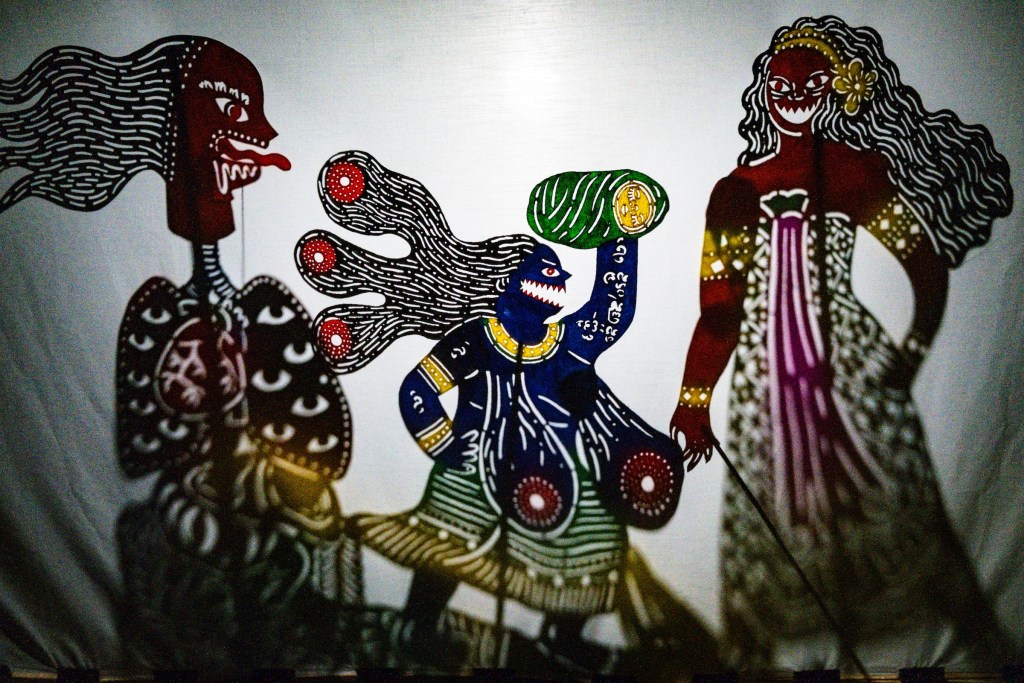Preserving the Age-Old Art of Malaysian Shadow Puppetry


KELANTAN, MALAYSIA — A puppet with flowing hair and a sharp-toothed grin came soaring into view as background singers shrieked, cackled, and whooped. Illya Sumanto spread her arms wide, making the beautiful ghost Pontianak glide across the screen, surfing on a banana.
“To play Wayang, you need big movements, but traditionally, women [in Southeast Asia] were expected to be small, moving gracefully,” Sumanto told Hyperallergic.
It was Sumanto’s first shadow puppet performance in November, in front of hundreds of people in Chiang Mai, Thailand. But she had received her training in Kelantan, a deeply conservative state in northern Malaysia.
Traditional Malaysian shadow puppetry of the country’s Kelantan region, known as wayang kulit Kelantan, is a dying art, in part because it’s been suppressed by the local Muslim government. Traditionally, the performance tells the story of the Ramayana, an epic poem that serves as a foundational text of Hinduism.
For years, the art form was banned outright in Kelantan, and even today, it can only be performed at two government-approved sites, a far cry from its original practice of roaming puppeteers performing in public spaces among communities.

Today in Kelantan, only the oldest generation remains familiar with wayang kulit. One middle-aged woman who sells the local delicacy nasi kerabu — marinated chicken with blue rice — told Hyperallergic in December that she watched one shadow puppet performance and was unimpressed.
“My husband said it was not authentic, but we don’t know anymore where to find the authentic one,” she said. “Actually, I’m ashamed that I don’t know much about wayang kulit, because it’s our cultural heritage.”
Muhammad Dain Othman, known as Pak Dain (“Uncle Dain”), the last living master, or dalang, of wayang kulit, said he doesn’t blame the government for the art’s disappearance — he blames society, which he claims broadly supports the religious prohibitions.
“Middle-aged people agree with the government, and the young generation is very busy with modern technology, so what’s left?” he told Hyperallergic during an interview at his cultural center in Kelantan. A devout Muslim himself, he’s exasperated by the religious criticisms.
“I only tell the story, I don’t demand people follow the beliefs,” Dain continued.
Dain said he feels a tremendous responsibility to preserve wayang kulit, but doesn’t quite know how. He’s built a museum where he sits surrounded by grainy portraits of dead puppeteers, including one of his apprentices, who he says was nearly done with his training when he died.

He struggles to strike the right balance between preserving wayang kulit’s traditional roots and adapting it to remain relevant in the modern age. To appeal to the younger generation, Pak Dain puts on shows about Star Wars, Predator, and the Marvel movies. He has also broken with another long-standing tradition by teaching women, such as Sumanto.
Wayang kulit originated in the Indonesian island of Java, and different versions of the art form exist across maritime Southeast Asia. Legend says it was first brought to Kelantan by a woman, a Thai-Chinese seafaring trader who picked it up in Java before being shipwrecked in northern Malaysia. Despite this, there’s never been an officially recognized woman master of wayang kulit Kelantan. There have been some in Indonesia, although female dalangs there say they still grapple with discrimination.
“Society still looks down on female puppeteers — we’re considered less attractive and less capable of performing, because female puppeteers are [believed to be] constrained by their voice, power, dexterity and skills and are considered to have less energy or stamina,” Sri Harti Kenik Asmorowati, a dalang in Indonesia, told Hyperallergic.
But Asmorowati said being a woman can also be an advantage because it brings something fresh and unique to a traditional art many are losing interest in, adding that she often focuses on female characters and perspectives.
Pak Dain is still coming to terms with the concept of a woman dalang. He harps on the difficulty of a woman voicing a male character during a performance.
“I don’t have any experience watching a woman dalang, so I can’t say, but I think it’s a little weird. But why don’t you try?,” he said he told Sumanto.

Coming to rural Kelantan as somebody who grew up in the capital Kuala Lumpur, Sumanto initially “felt like an outsider,” she said during a conversation with Hyperallergic at a bustling food festival in Chiang Mai.
“I asked myself, ‘Am I appropriating [the culture]?’ But Pak Dain told me: ‘This is yours too, Illya’”.
Random friends and acquaintances occasionally approached the table, adding their own questions and observations into the mix. Artistic juices always flowing, Sumanto reimagined the scenario as an improv skit or a short story. At one point, she stood up and danced a twist while explaining a traditional Malay dance called the “Joget Lambak.”
“I think he thinks I’m doing this just for fun,” Sumanto said. But as a performing arts teacher at one of Chiang Mai’s most prestigious international schools, Sumanto takes play seriously. “I’m having fun, but I’m serious.”

There are structural complications that Sumanto and Pak Dain must navigate for her to become a dalang. An apprentice’s teacher can’t sit on their evaluation board, which must include dalangs, master musicians, and veteran audience members. As Pak Dain is Sumanto’s teacher, they’d need to bring in shadow puppet masters from a different school to evaluate her — another bending of the rules.
But there are more rigid barriers. Time. Mortality. Pak Dain is in his 70s and keenly aware of his place as the last living dalang. He’s tried to cut down on cigarettes by not smoking in the evenings, but like a misguided intermittent faster, still smokes heavily in the morning and afternoon.
Sumanto’s first wayang kulit performance in Chiang Mai focused on ghost stories, which are typically shared across different countries in Southeast Asia and often revolve around female demons. But she flipped the script, recasting these ghosts first as misunderstood and then as heroes.
The Wayang Women troupe included a Thai-Nigerian student of Sumanto’s playing traditional Thai instruments, a Dutch-Indonesian singer, a Malaysian DJ and sound mixer, and a Balinese musician named Tigra Rose.
A classically trained pianist, Rose has also mastered a number of traditional Indonesian instruments. Days before she flew to Chiang Mai for the show, she serendipitously met an Indonesian dalang in east Java.
“No coincidences, right?” Rose said. The dalang taught her a traditional form of poetic singing, which she later incorporated into the performance in Thailand.

“I think women supporting women is always a very empowering and inspiring feeling,” she said of working with the all-woman cast.
“It’s also about sharing the knowledge, wisdom, stories and experiences, learning from each other and learning that at the end of the day we’re all facing similar struggles: patriarchy, the erasure of women’s voices in certain spaces, the work of preserving cultural heritage while still allowing it to evolve,” Rose continued. “Everything is connected and intertwined.”
Though he did not consider the ghost story performance to be a traditional example of wayang kulit Kelantan, Pak Dain was still supportive of Sumanto’s more experimental take. Likewise, Sumanto emphasized how much she had learned from her teacher.
“I gave him my puppets and asked, ‘Can you show me?’” Sumanto said. “He just improvised a story around my characters, and the way he embodied each one was so impressive.”
For her next performance, she plans to keep things more orthodox, retelling the Ramayana from the perspective of the female characters who are normally relegated to the fringes.
“I play what I’m taught, but I add my own layers and stories,” Sumanto said. “I don’t want to wait until I’ve finished [training] — I want to create while I’m learning.”




